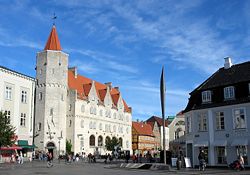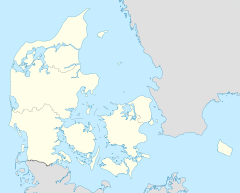Aalborg
| Aalborg | |
 |
|
| Country | Denmark |
|---|---|
| Population (2008) | |
| - Total | 121,818 |
| Website: http://www.aalborgkommune.dk/ | |

Aalborg (pronunciation IPA IPA: [ˈʌlb̥ɒːˀ]) is a city in Denmark. Its population, as of 2008, is 121.818, making it the fourth largest in the country after Copenhagen, Aarhus, and Odense. The earliest settlements date back to around 700 AD. Its location by the Limfjord made it an important harbour during the Middle Ages, and an industrial centre later. Today the city is in a transition from a working-class, industrial city to a knowledge-based one. One of the driving forces in the transition is the University of Aalborg, founded in 1974.
It is the location of Aalborg Air Base, an important base of the Danish air force, and is the seat of a bishop within the Danish National Church.
Contents |
History
Aalborg traces its history back over 1000 years. It was originally settled as a trading post, because of its position on the Limfjord. The sites of what were two settlements and a visible burial ground can be seen on Lindholm Høje, a hill overlooking the city. The size of these settlements emphasise the significance of this place as a crossroads.
The first mention of Aalborg under its original name Alabu, is found on a coin dated to 1040. An alternative spelling is Alebu and an approximate translation of the name is The (dwelling) place by the stream.

During the Middle Ages, Aalborg prospered and became one of the largest cities in Denmark. This prosperity was further enhanced when in 1516 Aalborg was granted a monopoly in salt herring. The herring fishery linked Aalborg to the East coast of England, across the North Sea, both in commercial competition and cultural exchange. The panelled interior from an Aalborg house in the National Museum, Copenhagen (illustration), shares many details with Jacobean panelled rooms.
Aalborg received town privileges in 1342 and the bishopric dates from 1554.
During the German invasion of Denmark in 1940, the Aalborg Aerodrome was captured by German paratroopers very early in the action and Aalborg is said to be the first city ever to be captured by paratroopers. The aerodrome was crucial for German aircraft to be able to reach Norway.
The First European Conference on Sustainable Cities and Towns took place in Aalborg, in 1994. The Conference adopted the Aalborg Charter (http://ec.europa.eu/environment/urban/pdf/aalborg_charter.pdf), which provides a framework for the delivery of local sustainable development, and calls on local authorities to engage in Local Agenda 21 processes.
The 4th European Sustainable Cities and Towns Conference ("Aalborg +10": http://www.aalborgplus10.dk/), held in Aalborg in 2004, adopted the Aalborg +10 Commitments. These commitments are an important step forward in turning sustainable urban development from words into real actions.
Transportation

Aalborg Airport is the local airport.
The city has a main train station, close to J. F. Kennedy-Square.
The European route E45, going from Finland to Italy, passes through Aalborg.
Industry
Aalborg is a still an industrial and commercial centre in Denmark, exporting grain, cement and fish, but many of the big industries in the city have been closed in recent years.
Aalborg is home to De Danske Spritfabrikker's ("Danish Distillers") akvavit snaps, production facility for the distillation of the Aalborg family of akvavits consisting of 17 different brands. Danish Distillers is Scandinavia's largest producer and supplier of spirits for consumption, and is the world's largest producer and exporter of akvavit, supplying over 140 geographic markets.
It is also the centre of telecommunications industry originating from the University of Aalborg.
Aalborg Industries, the world's largest manufacturer of marine boilers, is headquartered here.
Main sights
The old Aalborghus Castle (Aalborghus Slot) and some picturesque houses of the 17th century remain in the center of the town. The half-timbered (bindingsværk) castle was built in 1550 by King Christian III, and was converted to government administration offices in the 1950s.
Jens Bang's House, a five story building built in 1624 by the merchant Jens Bang is an example of renaissance architecture. It is located on Nytorv next to the old Town Hall.
The present Budolfi Church dates from the end of the 14th century, although at least two earlier churches stood on the same spot. Budolfi Church was just a parish church until it became the seat of the Lutheran bishop of Aalborg Diocese in 1554.
Vor Frue Kirke (Church of Our Lady) is a relatively modern church. The original Church of Our Lady from the early 1100's was pulled down after the Reformation because it was so old and unstable. The newer building in a different location was partially burned in 1894.
Underneath the main pedestrian shopping street is a newly opened museum of the excavation of a monastery from the 11th century.
Aalborgtårnet is a tripod tower erected in 1933. The tower still gives an exquisite view over the fjord and the city from its 105 m rise over the sea level. Just below the hill of the tower is Aalborg Kunstmuseum (Aalborg museum of Art) in a building designed by Finnish architect Alvar Aalto.
On the north side of the Limfjord is Nørresundby, which is connected to Aalborg by a road bridge, an iron railway bridge, as well as a motorway tunnel running under the Limfjord. Nørresundby is the site of the Lindholm Høje settlement and burial ground from the Germanic Iron Age and Viking times. There is also a museum on the site.
Aalborg Historical Museum is located in the city.
In 2008 the Utzon Center, dedicated to the work of the noted architect Jørn Utzon, was built next to the Limfjord at the central harbour front in Aalborg. Born in Copenhagen, Utzon grew up in Aalborg. The center contains an exhibition on Utzon's work, which included the Sydney Opera House, as well as educational displays on architecture and design.
Carnival in Aalborg
The annual Carnival in Aalborg takes place in the weekend of week 21 (usually the last week in May). The Carnival is actually three events, the children's carnival (Børnekarneval), the battle of carnival bands, and the carnival itself.
During the carnival, Aalborg receives about 100,000 people. The children's carnival is a carnival dedicated to the children, with performances and activities for children. Friday “The Battle of Carnival Bands” is an exciting and colourful evening with processions through the city when all the participating groups compete to be the leading carnival group.
The carnival itself is the following Saturday – on this day the city centre is full of life. The streets are filled with gaily dressed people who are in a real spring mood. In Kildeparken concerts are given from various stages all day to midnight. The Carnival ends with a grand firework display.

Jomfru Ane Gade
One of the most popular and famous streets in Aalborg, maybe even in Denmark and parts of Norway, Sweden and Germany, is Jomfru Ane Gade, or simply just Gaden ("The Street"). The name translates to "Virgin (or Miss) Anne's Street" in English. The pubs and restaurants on this street offer beer and other spirits for some of the most competitive prices in Denmark.
Jomfru Ane Gade is a café and restaurant street during day which, at night, turn into clubs, discos and bars. During the 1990s the street was infamous for being a 'hang out' of two biker gangs who were at war for some years all over Scandinavia, but as the bikers disappeared from the street it became even more popular among people of all ages.
During the day, tourists and employees in the city use the street as a restaurant street. In the afternoons some of the cafés open. Around 11 pm the mood of the street changes into more of a party street when younger people 'show up'.
Twinning
Aalborg maintains cultural, economic and educational ties with 27 cities around the globe [1] . Thus, Aalborg has the most twin cities in Denmark. Every four years Aalborg gathers youth from the majority of its twin cities for a week of sports games, known as Ungdomslegene (The Youth Games).
|
Other information
The city is home to the football team Aalborg Boldspilklub, known as AaB for short, which competes in the Danish Superliga championship. The club won the Danish Superliga in the 1994/95 season, the 1998/99 season and the 2007/08 season. The team qualified for the group stages of the 1995-96 and 2008-09 UEFA Champions League seasons.
The city has Denmark's highest number of hairdresser shops, tattoo parlours, bars, nightclubs, pubs and solariums per inhabitant.
See also
- Aalborg monastery
- Aalborg Municipality
External links
- Satellite image from Google Maps
- Official Aalborg City website
- Aalborg tourist office
- Aalborg University
- Aalborg Akvavit
- Ålborgtårnet
- http://www.indiansinaalborg.co.nr - A site with general information on Aalborg and the Indian community
|
|||||||||||||||||||||||||||||||||||||||||||||||||||||||||||||||||||||||||||||||||||||||||||||||||||||||